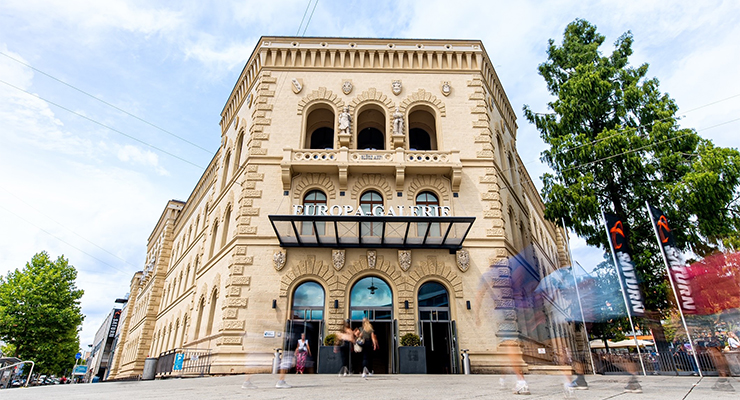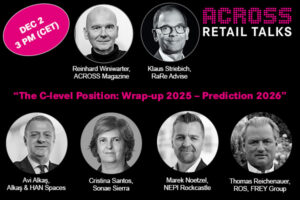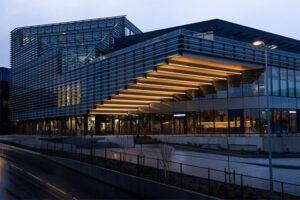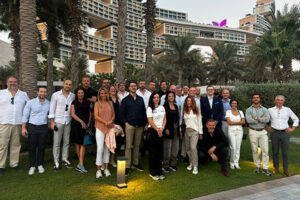The discussion was moderated by Reinhard Winiwarter, Founder and Publisher of ACROSS Magazine, who spoke with Christine Hager, Director Property Management, Sonae Sierra, and Dirk von der Ahé, Head of Leasing, Sonae Sierra.
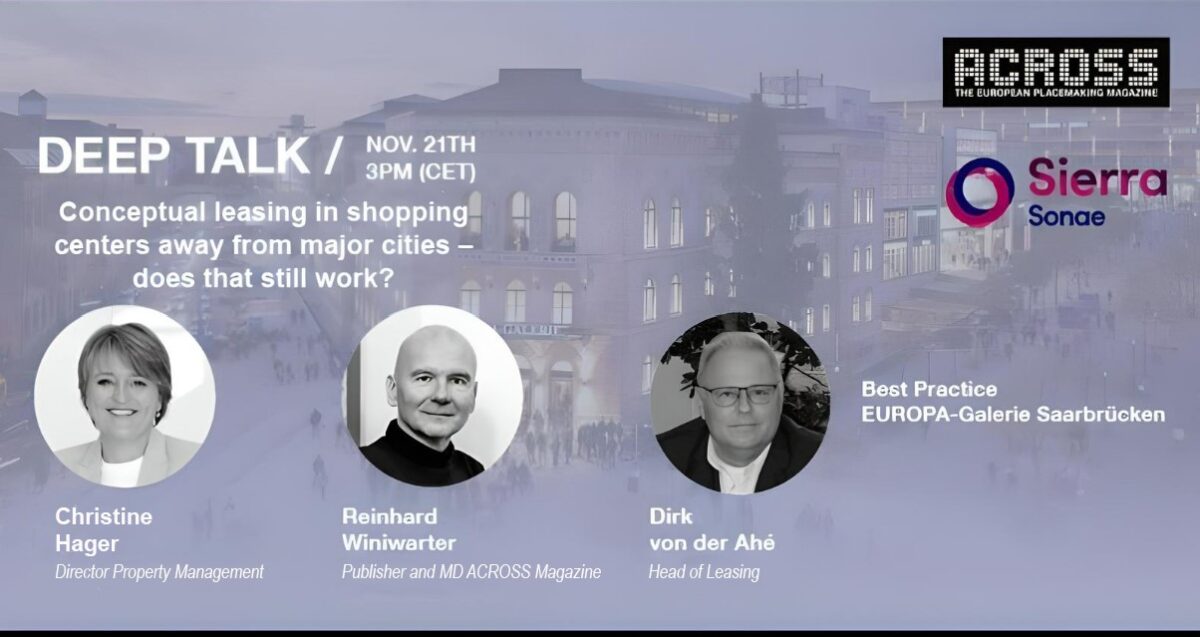
Polarization Between Non-Metropolitan and Top Locations
Christine Hager, Director Property of Management at Sonae Sierra opened the discussion by addressing the polarization between locations of differing popularity. “Clearly, there is an apparent polarization between the top A-locations and the many, less popular B-locations, and it is also the case that the better location is the enemy of the good ones everywhere. Every industry, and sometimes even every retailer within an industry, has different requirements, specifications and necessities that also change. It is a dynamic process, where no one can say they knew it once and then will always remain the same. Our job is, of course, to know these answers and to respond to them. In general, I can say that retailers are less and less willing to compromise and prefer to wait for the right situation and the right conditions because the pressure has generally decreased, so most of them can afford to wait a little.”
Dirk von der Ahé, Head of Leasing at Sonae Sierra, agrees with Hager, and explains that “there is much less flexibility when looking for a location.” To further elaborate, he brings an example, saying “A few years ago, expansion managers had the target of doing 10 or 20 locations a year, and thanks to their excellent network and knowledge of the market, they then picked out the best locations and opportunities. That has changed completely. Today, many receive specific guidelines from their sales team and management, specifying in which city, street and sometimes even in which house number they want to be.”
“In addition, there are changes for expansion managers in terms of profitability: costs, store fitting, personnel, logistics, energy,” he adds. “All these costs are rising at the same time, but the sales department tends to make conservative estimates. In other words, sales do not increase to such an extent that the additional costs can be borne. Conversely, it becomes necessary to find locations where either the sales expectation is so high because they absolutely want this location, or they find a landlord who compromises on the conditions so that they can compensate for the additional costs. This leads to the sales department rating the prime locations in the top cities very highly, which, in turn, leads to an increase in the search for such locations.”
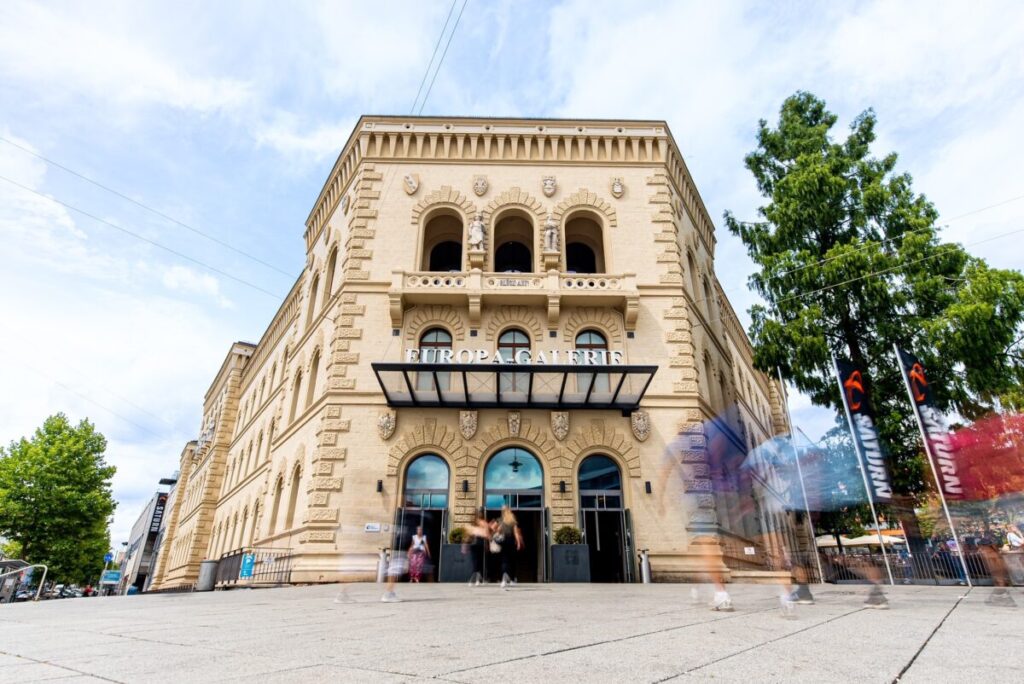
Europa-Galerie Saarbrücken
The Union Investment-owned “Europa-Galerie” in Saarbrücken, Germany, has around 25,000 sq m of retail space, around 100 rental units and around 1,000 parking spaces. The center is spread over 3 levels with one level offset and is located directly next to the city’s train station, with its current estimated catchment area amounting to around one million inhabitants. The building’s origins go back to 1990, whereas, in 2010, it reopened under its current name under ECE’s management. Sonae Sierra took over the management of the center at the beginning of 2022.
Sonae Sierra’s leasing strategy parameters for Europa-Galerie
“The location must not only be examined, but above all understood,” says Hager. “What catchment area do we have? In this case, it’s really close to the border, just a stop to France. Ideally, we also need as much information as possible about the current customer groups, and how we can reach them. The competitive location in the catchment area of the center is quite clear. Then, one needs to consider structural constraints and do a dedicated analysis of the current tenants in the center. That is the be-all and end-all. Finally, not only the rent needs to be known but also the turnover, because we can already tell a lot just by closely following the two.”
“Also, regarding management, it is very important to have close coordination with the property owner from day one and, above all, to have a shared understanding of how the location is currently performing,” continues Hager. “This means that you can work together in the right direction and have a good and trusting handover from the previous manager.”
When setting up a winning leasing strategy it is important to define:
- what the center actually needs, and what the requirements are.
- which customers you want, and what their preferences are.
- the current requirements of the retailers, i.e. the sectors you want to cover.
“Once these are available, you can then develop a concept adapted to the location and the center, and once the basic framework data has been defined, the concrete planning can begin,” adds von der Ahé. “Which tenant needs to be located where within this sector? Where do anchor tenants need to be located to properly distribute footfall in the center? What requirements do these anchor tenants have and where can we fulfill them? After all these questions are answered, the costs and rents can then be determined and compiled.”
A whole team of experienced specialists and experts worked together on the Europa-Galerie project. Von der Ahé continues by explaining how setting up a successful leasing strategy “starts with the rental department, but the marketing department, the market research development department, the legal department and, above all, the center managers’ local expertise and local knowledge are incredibly important, and are a core part of the overall concept as well.”
Increasing importance of a center’s marketing strategy
“Marketing has changed massively in the last 5 or 10 years,” says von der Ahé. “Professional B2B marketing is becoming increasingly important and is the key to successfully implementing a leasing concept. So once the leasing concept is in place, the individual marketing concept is developed, starting with where and how we want to present the leasing concept, and who the key stakeholders that we need to win over and convince are, and how we convince the important tenants of the location and, above all, how we convey the confidence that we can also implement this concept. Also, the way we approach retailers when implementing the concept, and how we convince them of it can be very different, since we approach an international corporation differently than a small regional retailer.”
Moreover, product strategy is actually the be-all and end-all, it’s what everything builds on to a certain extent. However, Hager is of the opinion that many investors and landlords underestimate the importance of a holistic B2B marketing concept and may save money in the wrong place. In this respect, Sonae is doing this very successfully. For example, the operator’s marketing strategy last year made good use of the UEFA European Championships. She explains that “this is a product that can be sold over and above the usual rental brochure, which in our view goes even further and is a key component of our success.”
Von der Ahé adds that “B2B marketing and B2C marketing are very closely connected, and there are measures that are important and good for both areas. However, there are also areas that are presented differently, because we naturally have different approaches for different reasons, but these must be closely interlinked and networked with each other. It cannot be done in parallel. Even if the two are not managed by the same team, the two different specialist teams need to be well coordinated.”
“In our case, it is very important that both owners and managers develop a joint strategy and pursue this goal together,” Hager explains. “As such, it is essential to be able to speak openly with each other in confidence. ‘Know your client’ is, I believe, alongside ‘know your asset’, the absolute key criteria for successfully operating together here.”
In this regard, having a location in an A-city or a more remote area invites a completely different approach to marketing. “Being close to the border with France means that we also have to take this into account in the rental concept, as well as the communication concept,” continues Hager. “For example, at Europa-Galerie Saarbrücken, we do all communications, including bilingual ones. Moreover, we also do Out of Home in France as well.”
“In this respect, it is extremely important for us that we were able to win over a center manager who is anchored in the city, whom we do not have to teach the city first, who knows the network and is ideally also well connected in the city,” Hager adds. “So when it comes to appealing to customers, we are not just talking about international brands that we hope to attract to the location, but also, in this case in particular, the local offer and the local tenants that you attract in the surrounding area.”
“At Saarbrücken, we need to find tenants that do not yet have a store in the city or the region,” says von der Ahé. “More precisely, we are constantly looking for new anchor tenants that appeal to this increased catchment area or extended catchment area, and move back into centers, as well as for those that also have a unique selling point. We have to convince them to expand and occupy flagship stores at the location, and that has been the leasing concept with which we are approaching the market.”
Europa-Galerie has numerous big brands, among them many Inditex brands. In the first place, to attract a retailer of their caliber, Sierra had to properly implement the key points of its concept. “Taking the case of Inditex as an example, it is important that once the concept has been agreed on, it has to be presented clearly and comprehensibly so that it can be recognized immediately, continues von der Ahé. “Then, it is key to build up a good relationship with Inditex and present it to them. Meanwhile, one also had to know the requirements and prerequisites of the different brands, as there is no use in offering 300 sq m to Berschka or 1,200 sq m to Pull&Bear.”
“Following the preparatory stage, the first significant step is that you have to win over the expansion team in Germany, as well as the decision-makers from Spain and the people responsible for the respective brands, so that you can convince them to visit the location and show them around. At this point, it is imperative to know how to present the new concept on-site so that it is the most impressive and understandable. In our case, we even made animations with the desired stores already included in the center, and where the adverts are on the façade, so that they can imagine exactly what their stores look like here at this location.”

About Sonae Sierra: Sonae Sierra is an international retail real estate company dedicated to delivering solutions to meet clients’ ambitions. The company develops and invests in sustainable retail assets and provides investment, development and property management services for clients in geographies as diverse as Europe, South America, North Africa and Asia, while creating shared value for the retail industry and society. To date, they manage around 650 assets and have delivered projects in as many as 35 countries.
Europa-Galerie’s tenant lineup
“We have many brands scheduled for opening their first stores at the center,” reveals von der Ahé. “To provide a few examples, I’ll start on the first floor. This is the area where fashion brands should be appropriate. There, it is important to set the right anchors in the rear area in order to draw people through the center. Berschka has recently moved there with 1,200 sq m and opened a flagship store, and Olymp and Hades are already next door. We have also opened Pull&Bear in this area, whereas JD Sports will expand to 640 sq m and also have a flagship store in the lineup. This means that we have concentrated service expertise in this area and will attract customers accordingly.”
“Moving on to the ground floor, we already have the supermarket at the back, and we also planned to convince dm to move down there too, but unfortunately, a year before we took over, they had spent a lot of money expanding and modernizing their store on the upper floor and it hadn’t been written off yet,” continues von der Ahé. “As a result, we went with Action and took another one that generates a lot of footfall and is an anchor tenant together with the supermarket. In the front area, where we said there is also fashion, we have H&M and now Stradivarius and the bestseller group with Only, Jack Jones and Vero Moda.”
“Additionally, we still have around 10 stores on the ground floor and first floor, where we are now looking for the right concepts to suit these anchor tenants,” adds von der Ahé. “Demand has increased massively, so we can now look to identify which of the brands really suit these anchor tenants. I think we will have signed these 10 remaining smaller, medium-sized stores by the middle of next year, and they will open next year as well.”
Sonae Sierra’s key takeaways on the successful management of a center in a non-metropolitan area:
- Find a location with good potential
- Win over the investors and allocate the budget well
- Have an interdisciplinary team of specialists with an excellent network
- In addition to the leasing concept, a clear marketing strategy is crucial
- Bring a willingness to adapt and be flexible during the process.
Discounter formats in centers
The presence of discounter retailers is once again becoming more widespread in shopping centers. Von der Ahé explains his view on the format, saying “We ourselves probably do not like discount stores in our shopping centers. 20 years ago, nobody wanted an Aldi in their center. Today we are running after it. But you have to realize that the discounters are not expanding because they simply want to, but because the demand is there and growing.”
“We have a difficult economic situation and even in healthy cities, consumers are more price-conscious when shopping, and we do not only have healthy cities,” he adds. “That is why these discount concepts are increasingly growing into locations where they would never have been seen a few years ago. They are increasingly taking over the empty spaces in shopping centers, which are simply no longer being taken up by retailers. We have too much retail space overall, and our job as managers in a center is to give the center a structure. We have to serve all customers, but not mix everything. I have just shown this again with the Europa-Galerie as an example: Find the right areas that have synergies. We also picked Action, and it generated more frequency at the opening than Berschka, so you need both for a working synergy. There are enough examples, and I would like to take the Europa-Galerie for example, where, if you do it right and if you structure it correctly, the other tenants will be able to benefit well from the frequency of a discounter.”
The importance of leisure, entertainment, and F&B concepts
Sonae sees great importance in the leisure and F&B formats when it comes to a center’s lineup of tenants. Von der Ahé explains that “Mixed-use is the topic of the day and shopping centers must increasingly become central marketplaces. What you need to know, however, is that these uses, especially in buildings from the 1970s and 1980s, are always associated with very high investments. We need extended opening hours into the evening, on Sundays and public holidays. Then we need separate entrances, which have to be created. We need separate ventilation, cooling, and heating. All of this is necessary to ensure evening operation. Additionally, we need to ask and clarify questions about ancillary costs. But adding to the mix of uses and converting retail space that is no longer in demand is simply the task of the time.”
A recent example of Sonae Sierra planning 2 medical centers to convert retail space and generate additional footfall reveals that despite the locations having been secured for the long term, it still does not pay off in the area. “The investments are so high in all the topics I have just mentioned that the project will have to be postponed or perhaps abandoned. Yes, mixed-use is the task of the time, but perhaps the pressure in some areas needs to be increased to realize such projects,” adds von der Ahé.
Another point Sonae Sierra raises is the reuse of leisure areas. “We create large recreational areas, we convert all this, and then the service provider doesn’t work,” he continues. “You also have to take this into account directly in the planning when you invest so much money.”
Hager further elaborates on the topic of entertainment and gastronomy, saying that when it came to positioning within the center, whether food courts, for example, were previously downstairs or upstairs, they still had to be located right in the middle of the floor. “That has also changed,” she says. “We have different requirements, where we no longer want everything in one place, but spread throughout the center with many individual spots where I can take a break, where I can have a coffee. And if we are talking about casual dining, we would also like it near a movie theater. Thus, as an operator, you have to look where there is a movie theater and what the opening hours are, and have to not only consider the guests who eat there but also those who order online.”

Christine Hager
Christine Hager is Director of Property Management at Sonae Sierra Germany.

Dirk von der Ahé
Dirk von der Ahé is Leasing Manager at Sonae Sierra Germany.
